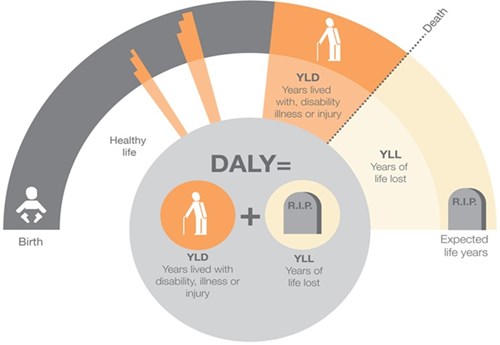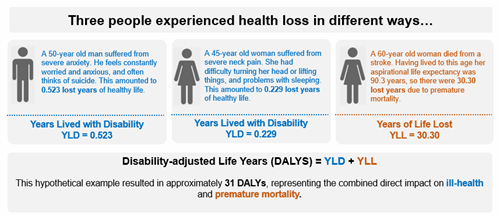Why burden of disease?
Burden of disease studies provide a consistent and comprehensive framework to address some fundamental questions on how early death and ill-health affect the nation’s population:
- What diseases cause the largest population health loss and how much do they contribute to health inequalities, nationally and sub nationally?
- Which risk factors are the strongest contributors to disease and death?
- How is the impact of different diseases evolving over time?
- And how does it compare between areas across Scotland?
Understanding which diseases and injuries pose the greatest threat to population health and well-being helps public health practitioners and policy-makers evaluate how to use limited resources for maximum benefit. They can plan interventions and deliver services to enhance prevention, improve disease outcomes, and reduce health inequalities
Drawing on the methodology of the Global Burden of Disease project, Public Health Scotland’s’, Scottish Burden of Disease Study (SBOD), has established a comprehensive framework for routinely quantifying the burden of disease for over 100 diseases and injuries in Scotland using the DALY (Disability Adjusted Life Year) metric.
What is a DALY?
Burden of Disease assesses how ill-health and early death due to disease and injury, prevent us living longer and healthier lives. Burden of disease studies use a single composite measure which combines the years lost because of early/premature death (years of life lost - YLL) and years lost because people are living in less than ideal health (years lived with disability - YLD). The measure used to describe the overall burden of disease is called the disability-adjusted life year (DALY) is simply the addition of YLL and YLD for each disease included in the burden of disease classification.

How is a DALY calculated?
The DALY is a measure of health loss, including both reduction in life expectancy and diminished quality of life. Mathematically, a DALY is represented by the equation DALY = YLL + YLD
YLL depends on the frequency of mortality and the age at which the death occurs. YLL is calculated as the number of deaths x the standard life expectancy at age of death. YLL accrues faster for deaths at younger ages compared to older ages.
YLD depends on the frequency of ill-health caused by disease or injury and the level and severity of disability that is experienced. This means that highly prevalent conditions do not necessarily result in high levels of YLD if the disability weight is low. Long-term causes which are, on average, successfully treated or managed have relatively low disability weights.
An applied example of how DALYs, YLL and YLD are calculated is given in the infographic below:

Key publications
von der Lippe E, Devleesschauwer B, Gourley M, Haagsma J, Hilderink H, Porst M, Wengler A, Wyper G, Grant I. Reflections on key methodological decisions in national burden of disease assessments. Archives of Public Health. 2020;78:137. doi: 10.1186/s13690-020-00519-7.
Haneef R, Schmidt J, Gallay A,. Devleesschauwer B, Grant I, Rommel A, Wyper GMA, Van Oyen H, Hilderink H, Ziese T, Newton J. Recommendations to plan a national burden of disease study. Archives of Public Health. 2021;79:126. doi: 10.1186/s13690-021-00652-x.
Burden of Disease commonly used terminology
Burden of disease (and injury): The quantified impact of a disease or injury on a population using the disability-adjusted life years (DALY) measure.
DALY (disability-adjusted life year): a standardized metric that can be used to quantify the health loss due to dying prematurely or to living with the health consequences of diseases, injuries or risk factors. DALYs are a summary metric of population health. DALYs are an absolute measure of health loss; they count how many years of healthy life are lost due to death and non-fatal illness or impairment. They reflect the number of individuals who are ill or die in each age-sex group and location.
Disability: In burden of disease studies, this is synonymous for “loss of health”, or any, short or long term, departure from full health
Disability weight: Numerical representations of the severity of health loss associated with a health state. Disability weights are numbers between 0 and 1 that are multiplied by the time spent living with a health loss to determine the years lived with disability associated with the cause of that loss. In the GBD, disability weights are derived from a worldwide, cross-cultural study to compare the relative severity of health problem.
Early death: The burden from dying prematurely. Often used synonymously with years of life lost.
Fatal burden: The burden from dying prematurely as measured by years of life lost. Often used synonymously with years of life lost.
Health loss: The total burden from early death and ill-health. Often used synonymously with disability adjusted life year (DALY)
Health states: the consequences of diseases and injuries or their risk factors. Health state refers to an individual's levels of functioning within a set of health domains such as mobility, cognition, pain, emotional functioning, self-care, etc. Health states do not refer to general well-being (which is a broader construct) or to aspects of participating in society, although they clearly affect these other aspects of life and may be affected by them
Ill-health: Often used synonymously with years lived with disability.
Life expectancy: The average number of years of life expected to be lived by individuals who survive to a specific age
Non-fatal burden: The burden from living with ill-health as measured by years lived with disability. Often used synonymously with years lived with disability.
Risk factor: a clearly defined behaviour or constitutional (e.g., genetic), psychological, environmental, or other characteristic that is associated with an increased possibility or likelihood that a disease or disorder will subsequently develop in an individual
Sequelae: Consequences of diseases and injuries for which epidemiological estimates and YLD calculations are made. It encompasses not only the traditional clinical meaning, but also a broader categorization of health outcomes such as severity levels for a particular disease, injury or impairment.
Severity distribution: Severity distributions are a means of summarising the range of health loss suffered to disease which enables estimates of disease occurrence to be paired with disability weights to estimate Years Lost to Disability in burden of disease studies.
YLD (Years of Life lived with a Disability): In burden of disease studies this is also referred to as ‘ill-health’. YLDs are computed as the prevalence of different disease-sequelae and injury-sequelae multiplied by the disability weight for that sequela. Disability weights are selected on the basis of surveys of the general population about the loss of health associated with the health state related to a disease sequela.
YLL (Years of Life Lost due to premature mortality): YLLs are computed by multiplying the number of deaths at each age x by a standard life expectancy at age x. In SBoD we use an aspirational world life expectancy table developed for the Global Burden of Disease study.

